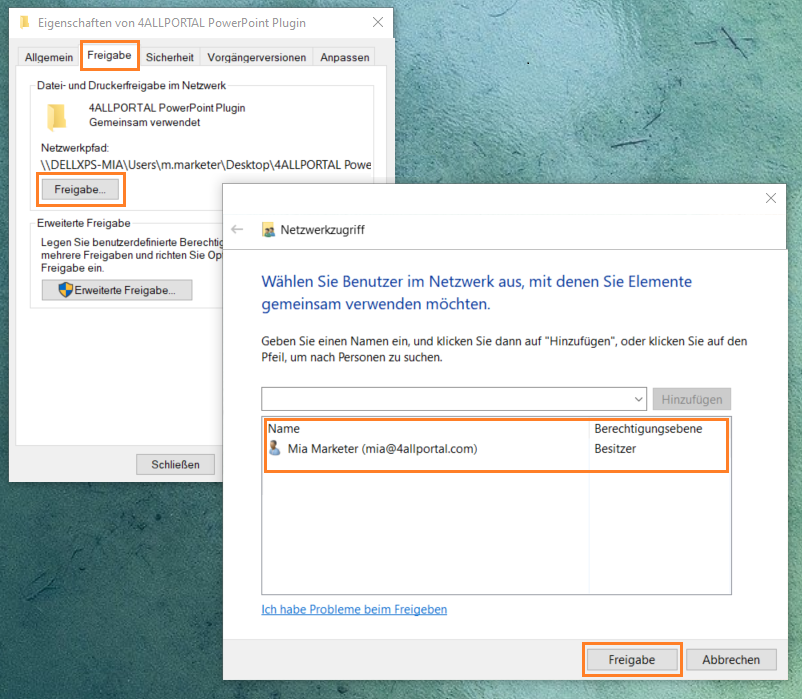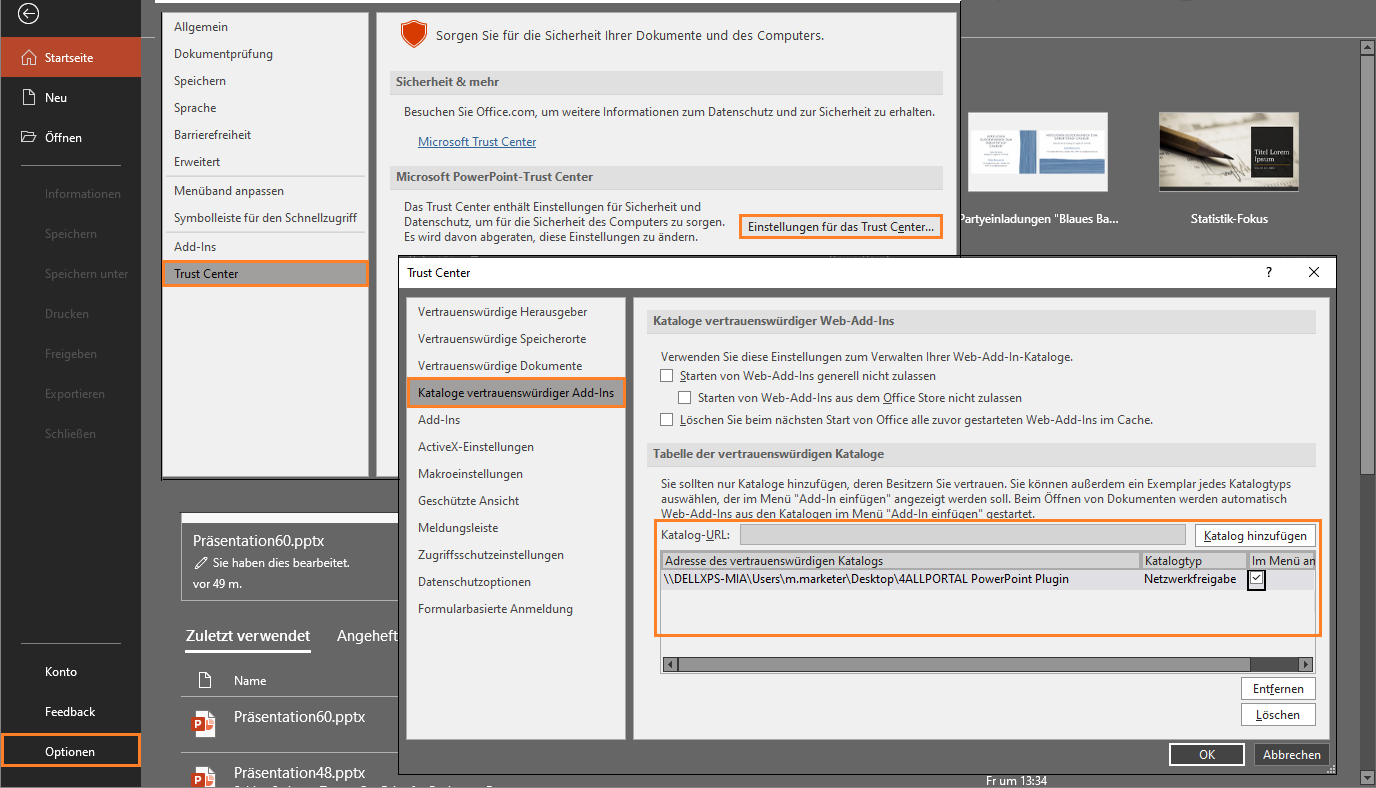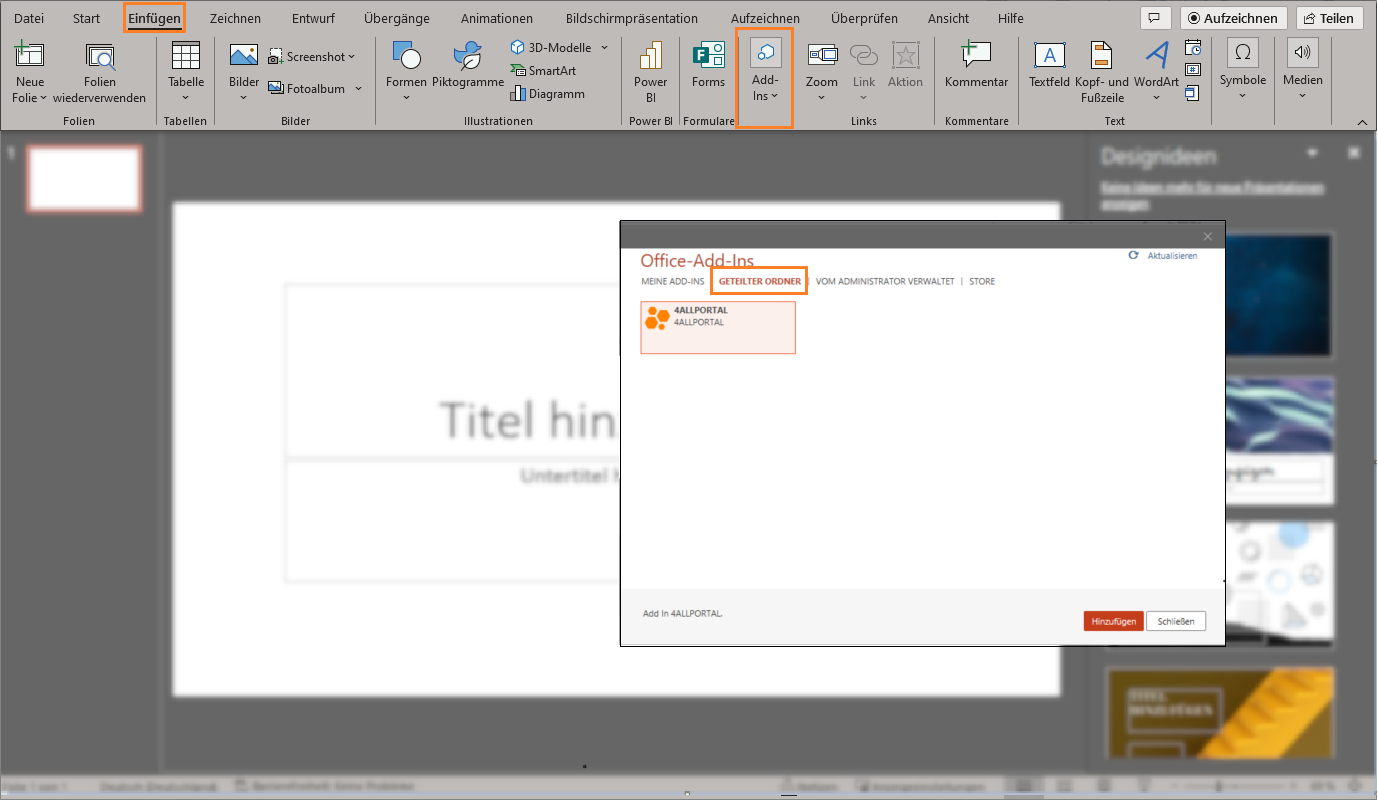Connect Plugin with PowerPoint
Once the system requirements are met and the 4App PowerPoint plugin is active on your 4ALLPORTAL, the 4ALLPORTAL can be connected to PowerPoint. You have two options:
- As a user: Each user can integrate the plugin into the PowerPoint application on their own computer (local installation).
- As an administrator: An administrator can integrate the plugin into the PowerPoint application via the network for all users or user groups of the company (global Installation).
For both installation types, the installation file is required.
Download Installation File
Regardless of whether you are installing as a user or an administrator, you will need the "manifest.xml" installation file. If the 4App PowerPoint Plugin is installed for your 4ALLPORTAL, you can download the file in your user settings area:
- Open the 4ALLPORTAL and click on your user name in the upper right corner.
- Select "Profile", then "Downloads".
- Click the "Download" button on the PowerPoint tile to start the download.
After downloading, please follow the installation instructions that apply to you:
Manifest.xml
Please note: Installation file "manifest.xml" contains specific information of the 4ALLPORTAL from which you downloaded it. You can use it to integrate only this 4ALLPORTAL into your PowerPoint!
If you do not find a PowerPoint tile in your download area, the required 4Apps are not installed in your 4ALLPORTAL yet. In this case, contact your administrator.
Local Installation (User)
The next implementation steps depend on whether you have installed and are using PowerPoint locally on your computer, or whether you are using PowerPoint as an online application in your web browser (office.com).
Please follow the installation instructions that apply to you:
- Local Windows installation
- Local macOS installation
- Web browser installation (office.com)
After a successful implementation, the 4ALLPORTAL plugin will be displayed in PowerPoint under the "Start" tab on the right as "4ALLPORTAL DAM" on the ribbon:
Local Windows Installation
For Windows, you have to share a folder and add it to PowerPoint's Trust Center. Just follow these 3 steps:
1. Create and Share a Folder
- Create a new folder at any place on your computer. Example: "4ALLPORTAL PowerPoint Plugin" OR go to an existing folder you want to use as your shared folder.
- Right click the folder and choose "Properties".
- Within the "Properties" window, click tab "Sharing", then under "Network File and Folder Sharing" click "Share ...".
- New window "File sharing" opens.
- If you want to share the folder only with yourself, your name and the note "Owner" should already be in the list. You can click "Share" directly.
- If you want to share the folder with other users/groups, you can do so via the drop-down menu. Make sure that read/write permissions are selected. Click "Add", then "Share".
- When you see the confirmation that the folder is now shared, copy the full network path that is displayed following the folder name.
Example: \\\DELLXPS-MIA\Users\m.marketer\Desktop\4ALLPORTAL PowerPoint Plugin
Please note: You will need to enter this value as the Catalog URL when you specify the shared folder as a trusted catalog, as described in the next section. - Click "Done" to close the "File sharing" window, then close the "Properties" window.

2. Add Folder to PowerPoint Trust Center
- Open a new document in PowerPoint.
- Open tab "File", then choose "Options".
- Choose "Trust Center", then click "Trust Center Settings".
- Choose "Trusted Add-in Catalogs" on the left.
- Enter the folder's full network path (including its name) to box "Catalog URL" and click "Add catalog".
Example: \\\DELLXPS-MIA\Users\m.marketer\Desktop\4ALLPORTAL PowerPoint Plugin
Hint: In case you forgot to copy the folder's full network path, you can get it from the folder's "Properties" dialog window, tab "Sharing". - Select check box "Show in Menu" for the newly added item, then click "OK" to close the "Trust Center" dialog window and "OK" to close the "Options "dialog window.
- Close and reopen Office, so your changes will take effect.

3. Add the 4ALLPORTAL to PowerPoint
- Move the "manifest.xml" file you downloaded from the 4ALLPORTAL into your shared folder.
- In PowerPoint, open tab "Insert" and choose "My Add-ins" to open the "Office Add-ins" dialog box.
- Choose "Shared Folder" from the top.
- Choose "4ALLPORTAL" and click "Add" to insert the plugin.
- Close PowerPoint and open it again to use the plugin. You may also need to close other Office applications, such as Word or Outlook.

Local Mac Installation
- Open Terminal and enter the following command: "open /Users/<username>/Library/Containers/com.microsoft.Powerpoint/Data/Documents/wef".
This will open the "wef" folder in Finder. - Note: If the "wef" folder does not exist on your computer, enter the following command: "open /Users/<username>/Library/Containers/com.microsoft.Powerpoint/Data/Documents".
This will open the parent folder "Documents" in Finder. Create subfolder "wef" here and open it. - Copy the installation file "manifest.xml" into this folder.
- Open a new document in PowerPoint (PowerPoint must be restarted if it already runs).
- In the ribbon, select "Insert", then "Add-ins". Then select "My Add-ins".
- Click on the drop-down menu (small down arrow next to "My Add-ins"). Select "4ALLPORTAL" and add it.
Web Browser Installation (office.com)
- Open a PowerPoint presentation in your web browser (office.com).
- Select the "Insert" tab and then select "Add-Ins".
- Select "Manage my add-ins" and then "Upload my add-ins".
- Select the file "manifest.xml" and upload it.
Please note: Microsoft 365 does not support the Internet Explorer.
Global Installation (Admin)
As an administrator, you can add the plugin to PowerPoint for all users or a user group. The plugin will then be listed in the "Managed by administrator" section at the top of the "Office Add-Ins" dialog box.
Requirements
- Access to the Office Admin Center
- Admin access rights
- Centralized deployment of PowerPoint
Before you start, use the Microsoft Centralized Deployment Compatibility Checker to determine if you can use centralized deployment of add-ins in your organization.
Set up Centralized Deployment
- Open the Office Admin Center and go to "Settings"/"Integrated apps".
- Select "Upload custom apps" and upload installation file "manifest.xml".
- Select an option and follow the instructions.
- On the next page, select "Everyone", "Specific users/groups", or "Just you" to specify to whom the add-in should be deployed. Use the search box to find specific users or groups.
- Select "Deploy".
- When finished, select "Next". If you have deployed to just yourself, you can select "Change" to deploy the add-in to more users.
- In PowerPoint, the plugin shows on the ribbon, tab "Home". At mouse over, the information tells users that this add-in is "Admin managed".
Users might need to relaunch Office to view the add-in icon ("4ALLPORTAL DAM"`) on their PowerPoint ribbon. Note that add-ins may take some time to appear on app ribbons.
If it does not show, users should try to add it via tab "Insert"/"My Add-ins"/"Office Add-ins" (like described above).